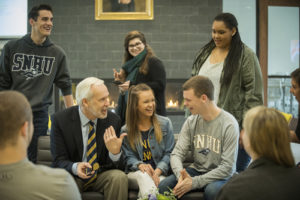Southern New Hampshire University (SNHU) is reimaging the traditional conception of college as the middle ground between high school and the workplace. In a merger with LRNG, a non-profit that serves disadvantaged youth populations, SNHU will work with cities and employers to develop innovative learning and workforce solutions.
The ambitious effort will reach out to both pre-college and older learners, offer opportunities to youth from low-income backgrounds to become more engaged with their studies and help them transition into rewarding careers. LRNG was chosen, in part, because of its groundbreaking platforms that use micro-credentials, badges, and playlists as part of the learning sequences.
“I told our team that we had to build a learning platform that accommodates an 11th-grader working on her associate’s degree as easily as it accommodates a 60-year-old formerly incarcerated adult working on his GED or high school diploma,” says Paul LeBlanc, president of SNHU.
Preparation has already begun in Chicago and Birmingham, Alabama, with plans to be fully operational in both cities by next summer. LeBlanc says that cities provide the ideal amount of scale for these solutions compared to the complexities of designing a statewide strategy.
SNHU is in the process of getting all of its systems, policies, and people in place before rolling out any formal programs, including:
- research to discover the workforce needs of each city and the obstacles confronting young people.
- identifying potential partners in a community and how they can work together. “We want to go into these with humility, but there’s a lot of social capital and hard work and good partners already in place, so we want to be a good partner to those angents of change, if you will,” says LeBlanc.
- coming up with curricular options pegged to individual circumstances for the right badges, micro-credentials, and what they can unlock. For example, young people enrolled in a summer youth employment program must complete an LRNG financial-literacy playlist and earn a financial-literacy badge to collect their first paycheck.
“We think of badges as unlocking something. In this case, it unlocks the opportunity to get paid,” LeBlanc says. “They developed a playlist and badge with The Gap on workplace readiness. When students complete that playlist and earn The Gap-endorsed badge, they unlock a guaranteed job interview with The Gap. The idea is that you don’t just do learning and hope people come. You link learning to an opportunity that’s related to work and education.”
SNHU will also open mini-campuses in these cities where learners can get comprehensive support, such as assistance filling out FASA forms, tutoring, a quiet place to study, or access to a fast internet connection. Working with cities one-by-one allows SNHU to come up with custom solutions that can take advantage of existing resources. For example, they’re working with the Birmingham library system to see about using individual branches as learning centers.
LeBlanc says that many cities have expressed great interest in working with him because they see the value of having an educated workforce with the right skills to plug their specific labor gaps.
For now, SNHU wants to get the process right and come up with a model they can present when they approach other cities. “We’re trying to reinvent the educational ecosystem in some ways and that’s a big goal. Most importantly, we’re impacting tens of thousands of students’ lives and giving them pathways for more education and meaningful work and thus an economic opportunity to improve their lives.”
- A bungled FAFSA rollout threatens students’ college ambitions - April 19, 2024
- Using real-world tools to prepare students for the workforce - April 18, 2024
- 8 top trends in higher education to watch in 2024 - April 16, 2024

